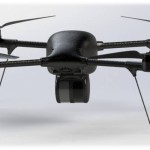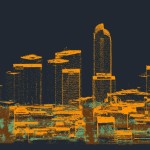By Alexander Reifsnyder
In recent years, society has seen an increase in the popularity of drones, and a corresponding evolution of the connotation of the word drone. Drones are now typically thought of as a fun toy quadcopter, not a multimillion-dollar air strike platform. As with most booms in popular consumer technology products, the sudden and growing demand for drones has led to very advanced innovation and new uses for these amazingly versatile machines.
It should be noted that the word “drone” isn’t particularly apt in some of the more common uses. For example, consumer and professional drones are much more like flying platforms than autonomous vehicles. This is the secret to the versatility of a drone. The base technology keeps improving because of demand, so developers of novel technologies only have to improve what they want to add to the drone. They can put anything they want on the flying platform technology and it becomes a _________ Drone.
This ease of inventing these “new” drones has led to some very interesting emerging uses. These applications can replace a human in a dangerous or tedious, but necessary, job. Here are the top three emerging uses for drones:
3) Agricultural Drones
Typically, when somebody thinks of a farmer they may not immediately assume familiarity with or use for drones. However, because of their versatility, drones are quickly being adopted by the agricultural industry. For instance, a large drone manufacturer named DJI has recently come out with a drone capable of spraying crops with fertilizer, insecticide, pesticide, etc. Drones can also be used to remotely monitor large fields. By combining monitoring with spraying, it is possible that we’ll soon have a system that can identify crops in need of more nutrients and send a fertilizer drone to enrich the soil in that area.
Drone crop-dusting is also safer than traditional crop-dusting. According to a US Bureau of Labor Statistics article, 10% of all pilot deaths were crop-dusters as of 1996. Many websites also list crop-duster pilot as one of the top 10 most dangerous jobs. It should come as no surprise that this is the case since crop-dusters are required to fly quickly and close to the ground while spraying a cloud behind them. They hit power lines in about 1/3 of crashes. Using drones for this application could save hundreds of lives by taking human pilots out of the air and keeping them safely on the ground and at the controls. In addition to saving lives and money, a recent article in The Motley Fool reports a big investment opportunity here as well suggesting that the use of drones in this one industry could be worth more than $32 billion.
2) Package Delivery
This may not seem like one of the most promising uses of drones yet but the technological improvements needed for package delivery will greatly expand the usefulness of drones. Currently, drones are valued for being lightweight and high speed, without worrying too much about battery life. Currently, the FAA commercial drone law (revised Part 107) blocks drones from being used for package delivery. There will need to be some major improvements in battery life and payload capabilities of drones, not to mention regulatory adjustments, before drones can be used to deliver a new sweater to a customer’s house. Most consumer drones can’t lift very heavy objects. In order to make drone delivery systems reliable and practical, drones with higher payload capabilities, longer battery life, and smarter collision avoidance systems need to be developed. All three of these improvements will benefit not only package delivery, but countless other uses as well.
This application is also important since it shows that when improvements need to be made to the base technology, the innovation happens a little slower. While many minor drone modifications are “Plug and Play,” making modifications to the base technology is a more difficult and time-consuming process. This innovation is important, however, since many other applications will benefit from the improvements needed for package delivery. In the meantime, as this New York Times article explains, amazon.com could make use of drones for some packages in some locations in the very near future.
1) Remote Inspection
Robots are often used to replace a traditionally human-operated task in situations where there is significant risk to the operator. One such situation is inspection of different machinery. Nuclear reactor fuel pools are regularly inspected and serviced by human divers. This is a very dangerous job and divers can make mistakes that could cost them their lives. The following story is from the book, What If?, by Randall Munroe.
“On August 31st, 2010, a diver was servicing the spent fuel pool at the Leibstadt nuclear reactor in Switzerland. He spotted an unidentified length of tubing on the bottom of the pool and radioed his supervisor to ask what to do. He was told to put it in his tool basket, which he did. Due to bubble noise in the pool, he didn’t hear his radiation alarm.
When the tool basket was lifted from the water, the room’s radiation alarms went off. The basket was dropped back in the water and the diver left the pool. The diver’s dosimeter badges showed that he’d received a higher-than-normal whole-body dose, and the dose in his right hand was extremely high.
…
The tubing was so radioactive that if he’d tucked it into a tool belt or shoulder bag, where it sat close to his body, he could’ve been killed. As it was, the water protected him, and only his hand—a body part more resistant to radiation than the delicate internal organs—received a heavy dose.”
This story reveals how easy it is for a fatal mistake to occur in this as well as many other inspection and service jobs. Imagine how easily this could have been avoided if a drone was sent to inspect the fuel ponds. It could be equipped with a radiation meter to map where it would be safe to swim and what objects are safe to touch. Perhaps it could even perform any maintenance itself.
Surveying and inspection drones would even be useful in less dangerous applications like inspecting roofs, towers, or any other structure. The drones would allow an operator to stay on the ground while getting a bird’s eye view in the air. In many cases, the drone can get to a location that would be inaccessible to a person.
According to a recent Harvard Business Review article, drones are currently being used to save money and improve safety in a variety of industries such as oil, railroads and mining. As the technology advances, we will continue to find many uses for drones. Right now, however, they are already making some of our most dangerous jobs safer.


